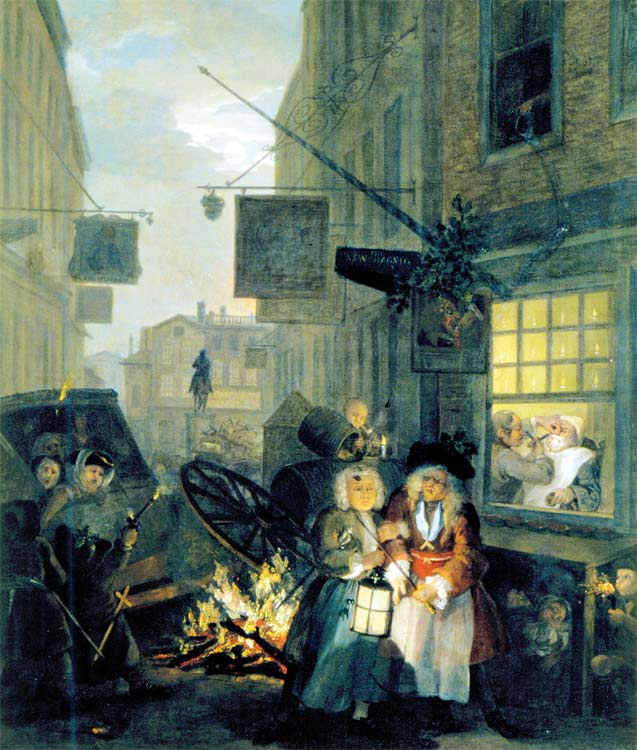Hograth, William: Night (from 'Four Times of Day', 1736)
The Independent's Great Art series

Also in this article:
About the artist
How many pictures can you find in a picture? The answer is usually: more than one. If the picture is any good, it will consist of several different kinds of picture, combined. Some you may prefer to others. Henri Matisse said: "When I see the Giotto frescoes at Padua, I do not trouble to recognise which scene from the life of Christ I have before me. I perceive instantly the sentiment that radiates from it, and which is instinct in the composition in every line and colour. The title will only serve to confirm my impression."
Like many 20th-century painters, Matisse believed that line and colour were far more important than story-telling. Even in an Old Master like Giotto, they were the emotional heart. The stories from the life of Christ were there but only as a pretext, something to hang the composition on. You didn't need to focus on them.
Now you may wonder at Matisse's knack for turning a blind eye. Did he really see only abstract pictures? Did he really not notice the subjects before him, until he read the titles? But he's only doing what other viewers say they do, when they look at a picture and talk about its different aspects or levels the narrative, the symbolism, the draftsmanship, the composition, the colour scheme, the light and dark, the brushwork etc.
Of course, it may be hard to literally separate out these aspects into different pictures. You couldn't do a version of a Giotto fresco that just had the line and colour, but didn't have the story. Put down the line and colour, and surely the story comes too (and vice versa). Or perhaps you could, if you had the nerve. After all, some artists do it for themselves.
The revelation of this year's Hogarth show at Tate Britain was the sequence of paintings called The Four Times of Day. These four scenes of London street life are rarely seen together. Two of them (Morning and Night) are in Warwickshire. The other two (Noon and Evening) are in Lincolnshire. Even more rare, they reveal a Hogarth who's not just a supremely inventive image-maker. He's a real painter.
The finest is Night. Here, darkness merges and reconfigures the world. Charing Cross appears against a cloudy, full-mooned sky, as a formation of silhouettes. The bunch-of-grapes emblem echoes the bright, same-sized moon, and hangs directly above the dark statue. The top of the scene is a perfect nocturne, a pattern of forms, where everything depends on fine-tuned gradations of grey and grey-brown.
In the bottom of the scene, small fires break out a bonfire, a lamp, a candle-lit window, each revealing a glimpse of human business. The foreground is occupied by shadowy figures and actions. A wagon wheel lies at a strange angle. There's a feeling of the darkness stirring. The city at night is a forest of signs, a deep wood filled with its nocturnal creatures. That's what Hogarth can do when he's being a painter.
But most Hogarth pictures exist in two versions as a painting and a print. Night is no exception. The print is (as usual) a mirror image of the painting. It is in black-and-white, in engraved lines. And here the scene is dramatically changed: whatever was obscure in the painting is made distinct; whatever was atmospheric is dispelled.
The print isn't interested in overall visual effect, but in readable detail. You see a coach crash, with people screaming and shots being fired. You see the images on the inn-signs. You see numerous clues, indicating the various social types involved. In other words, the print gives you all the I-spy stuff that Hogarth's commentators love to go on about.
A study in darkness is transformed into a scene of turbulent business and violence, full of passions and disasters, anecdotes, social observation and symbolism. In the painting, those telling details are submerged in shade. In the print it doesn't seem to be night at all, more like a graphic equivalent of cinema's "day-for-night", an artificial darkness in which everything remains clearly visible.
Actually, all the details that are in the print are also dimly present in the painting, and were probably a bit more visible when it was first painted. In his print version, Hogarth is only bringing out the latent story-telling aspect, at the expense of everything else.
In the process, he reveals the fact that Night is a divided image, consisting in effect of two superimposed pictures a mysterious nocturne and a midnight farce whose priorities are not just different but incompatible. A single picture couldn't do both. Yet it's only an extreme case of something quite normal. Almost any picture worth looking at has similar schizoid tendencies.
The artist
William Hogarth (1697-1764) is often named as the father of British art. He is much more than the bluff, plain-speaking Englishman of his own self-image. He's a big, complicated artist. He's a severe moralist. He's surreal. He has a sharp eye for high art and popular culture. He's interested in character. He makes jokes, both daft and savage. He's a panoramic observer of society. He packs his images with every kind of visual sign and symbol. Next to Hogarth, all other picture-making looks a bit specialised. And just occasionally he can paint.
Subscribe to Independent Premium to bookmark this article
Want to bookmark your favourite articles and stories to read or reference later? Start your Independent Premium subscription today.

Join our commenting forum
Join thought-provoking conversations, follow other Independent readers and see their replies